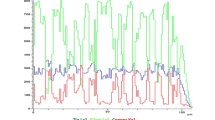Abstract
Model experiments to explore the amalgation mechanism in conventional Ag3Sn and high copper single-composition dental alloys have been conducted by rotating alloy roda in liquid mercury at different speeds and for different durations. After removing the rod from the mercury, the vacuum volatilization technique was used to accelerate the supersaturation of dissolved elements in the liquid mercury. The surface and sectional scanning electron microscope (SEM) views give direct evidence for new amalgamation mechanism in high copper dental alloys. The amalgamation reaction begins with the selective dissolution of the Ag3Sn phase in mercury, tin gettering to the crumbled-off Cu3Sn phase, heterogeneous nucleation of the Cu6Sn5 phase on the seed of the crumbled-off Cu3Sn phase and was followed by the nucleation of the Ag2Hg3 phase. The unexplained phenomena, the formation of the γ-2 phase (Sn7-8Hg) in higher content of mercury and the nonexistence of the γ-2 phase in higher content of copper alloys such as Sybralloy, were clearly understood by applying the new model.
Similar content being viewed by others
Explore related subjects
Discover the latest articles and news from researchers in related subjects, suggested using machine learning.References
K. Asgar,J. Dent. Res. 2 (1974) 53.
T. Okabe, R. Mitchell, M. B. Butts, A. H. Wright andC. W. Fairhurst,ibid. 57 (1978) 759.
Idem, ibid. 57 (1978) 768.
Idem, ibid. 57 (1978) 975.
J. R. Abbott, D. R. Miller andD. J. Netherway,J. Biomed. Mater. Res. 16 (1982) 535.
J. R. Abbott andO. F. Makinson,ibid. 13 (1979) 857.
S. J. Marshall andG. W. Marshall Jr,ibid. 13 (1979) 395.
D. B. Mahler,ibid. 13 (1979) 467.
P. G. Bosewell,Scripta Met. 13 (1979) 383.
Idem, J. Mater. Sei. Lett 15 (1980) 1311.
W. Kraft andG. Petzow,Biomaterials 1980 (1982) 327.
F. W. Hinzer andD. A. Stevenson,J. Phys. Chem. 67 (1963) 2424.
C. M. Schoenfeld andE. H. Greener,J. Dent. Res. 50 (1971) 350.
C. L. Reynolds Jr.,F. E. Wawner andH. G. Wilsdorf,J. Appl. Phys. 46 (1975) 568.
F. V. Level, Powder Metallurgy — Principles and Applications, (MPIF, New Jersey, 1980) p. 286.
T. Okabe andR. F. Hochman,J. Biomed. Mater. Res. 9 (1975) 221.
T. Okabe, A. L. Hives andR. F. Hochman,J. Appl. Phys. 47 (1976) 49.
Author information
Authors and Affiliations
Rights and permissions
About this article
Cite this article
Lee, K.H., Shln, M.C. & Lee, J.Y. Amalgamation mechanism in dental amalgam alloys. J Mater Sci 22, 3949–3955 (1987). https://doi.org/10.1007/BF01133344
Received:
Accepted:
Issue Date:
DOI: https://doi.org/10.1007/BF01133344




